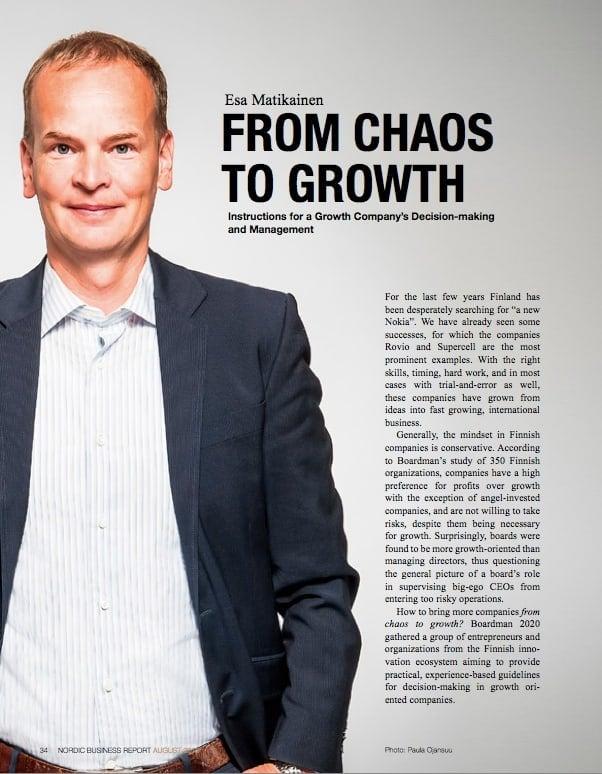16Aug2013
For the last few years Finland has been desperately searching for “a new Nokia”. We have already seen some successes, for which the companies Rovio and Supercell are the most prominent examples. With the right skills, timing, hard work, and in most cases with trial-and-error as well, these companies have grown from ideas into fast growing, international business.
Generally, the mindset in Finnish companies is conservative. According to Boardman’s study of 350 Finnish organizations, companies have a high preference for profits over growth with the exception of angel-invested companies, and are not willing to take risks, despite them being necessary for growth. Surprisingly, boards were found to be more growth-oriented than managing directors, thus questioning the general picture of a board’s role in supervising big-ego CEOs from entering too risky operations.
How to bring more companies from chaos to growth? Boardman 2020 gathered a group of entrepreneurs and organizations from the Finnish innovation ecosystem aiming to provide practical, experience-based guidelines for decision-making in growth oriented companies.
Discussions resulted in a distinction between a minimum level and best practices. Minimum level issues for instance include board agenda and composition, paperwork, CEO selection, and remuneration. The aim at the minimum level is to let you focus on developing the actual business. A good benchmark for having the paperwork in order is how long it would take your company to prepare for a due diligence – weeks or hours? Additionally, an ownership structure, which looked good at the start, easily declines over time not serving its purpose at a later stage. Examples include a board member suing the company, but still having a board seat guaranteed by the shareholders agreement.
Best practices include guidelines for aspects like diversity, access role, focus and inspiration. Best practices are expected to make a contribution, if they change the way that your board aims to add real value to the business. Board work is still about constructive critique and `asking the right questions’. However, at least as importantly it is about paving the way for when things get complicated. The board members should use their networks. They should prove access to potential customers, distribution channels and finance, providing enthusiasm and energy as well as a variety of views and solutions. The managing director should leave the meeting fully energized, because he or she got solutions for the most critical issues at hand.
Furthermore, strategic decision-making remains at the core of a board’s activity. However, more emphasis should be put on monitoring the implementation of strategic themes or projects with a right set of operative and strategic measures. These measures should enable protecting the focus by closing down unsuccessful projects early..
Finally, it should be emphasized that sales should never be a `too operative’ issue for a growth-oriented company’s board. The board should have sales and customers at the top of the agenda, thus helping the entrepreneur in creating a sales and market oriented culture. In today’s world applying exact operating principles becomes increasingly difficult and even irrelevant. It is important to raise the sense of purpose and strong vision at the center, since they are the drivers of successful companies. Future boards need to figure out how to contribute, not just in formulating the mission statement, but also in extending its contribution to strengthening the core of any growth-oriented company.
Instructions for a Growth Company’s Decision-making and Management
TOP 10 Minimum Level
1. Board meeting practices and agenda
A carefully prepared agenda always includes certain standard issues, such as financial situation, cash flow and sales estimates.
2. Paperwork
Make sure all the material is stored carefully and properly as well as signed.
3. Board composition
Include external members in the board, such as an investor and a board expert.
4. Equal treatment of shareholders
Make sure the board does not speak for one certain owner only or for a group of owners, but instead for the whole company.
5. Strategy and its implementation
The board is responsible for the strategy and the CEO is responsible for its implementation. Targets must be set clearly and well planned for both the company and the CEO.
6. Financial management and cash flow
Follow the company’s economical situation actively. The board is responsible for the cash flow and own capital.
7. CEO nomination
Remember that the different situations and development phases of the company require different management skills.
8. Basic practices of HR management
Ensure that the company applies appropriate basic practices of HR management. A growing company will always recruit, but a precondition for growth is the right team.
9. Shareholder agreement
Make a shareholder agreement to create clear rules in the company. Ensure everybody understands every clause of it.
10. Rewarding and compensation
Instead of mere payment, consider a complete reward system with basic salary, bonus, other benefits, shares and options.
TOP 10 Best Practices
11.Diversity
Acquire board members, who have versatile skills, education and experience backgrounds, personalities, visions and networks.
12. Contacts and networks
Utilize the board members’ contact networks of important, potential clients, partners, societal operators and investors.
13. Quality of board meetings
Focus on strategically important issues and selected themes. Just a review of the financial situation is never sufficient.
14. Inspiration
Create an atmosphere in the board meetings, which is inspirational and suits your company culture.
15. Will of owners
Make sure the board is aware of the owners´ will, and of their willingness to take risks. Their will should be reflected in strategy, goals and prioritization.
16. Short and long term goals
Keep the short-term goals realistic and their realisability credible. Dare to dream in the long term.
17. Financing need, innovations and strategy
Consider the actions which may be executed with the present financial grounds, and when and where from you get the extra financing.
18. Focus
Focus on issues that bring growth and profitability. Eliminate all pseudo tasks, such as reports that nobody reads.
19. Sales and marketing orientation
Remember that sales create growth. A growing company’s board cannot consider sales as ”too operative” task.
20. Purpose and meaningfulness
Keep purpose and meaningfulness in the epicenter. Money is not the only motivation or goal.
About the writer: Dr. Esa Matikainen is a business strategist and serves as a Member of the Board in numerous companies on IT-sector.
This article is from the August 2013 issue of Nordic Business Report. Read the full magazine here »

 by:
by: 


 by:
by: 